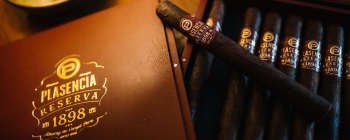
Cigar Sizes and Cigar Types - The Complete Guide
Cigar Sizes and Cigar Types
The cigar world can seem an expansive and rather daunting place, with so many different cigars form which to choose. Yet with a few tips, you can enjoy every step of your cigar journey with confidence and the greatest of ease.
Cigars come in a vast array of sizes and shapes or “vitolas” to accommodate the varying preferences of cigar enthusiasts. With each different type of cigar comes a uniquely different cigar smoking experience. This guide will help you sort through the various sizes and shapes to discover the perfect cigar for you.
Why Cigar Size and Type Matters
Size plays a role in the amount of time it takes to smoke a cigar, but also in the level of taste a cigar offers. To best select the right cigar, it helps to understand just how cigars are measured.
The length is a simple lengthwise measurement of a cigar from its head to its foot. A cigar’s diameter is measured in 64ths of an inch to arrive at its Ring Gauge. Each 1/64th equals one ring size, so a cigar with a diameter of 52/64ths of an inch, for example, is said to have a ring gauge of 52.
Cigar makers often blend cigars within a particular line differently, depending on the size of the cigar to maintain consistency in body and taste throughout all the sizes. Each size will offer a different smoking experience, even though composed of the same tobacco. A larger diameter cigar, for example, has more filler tobacco and might deliver a more complex and flavorful smoke than a smaller cigar of the same blend. So, size indeed matters when determining just how a cigar will fit your needs.
Learning cigar sizes will make it easier for you to experiment, as you can buy similar cigars to those you already like.
Ring Gauge
While length is indeed an important consideration, the ring gauge is a deciding factor for many cigar enthusiasts when choosing a cigar of a particular blend. Many cigar aficionados eventually settle on a favorite ring gauge, yet it can take some trial and error to find that magic number. So, when selecting a size, it helps to consider just how the ring gauge might affect the smoke.
Generally, the larger the diameter, the slower and cooler it will burn. And the smaller the ring gauge, the faster and hotter it tends to burn. This gives each size of cigar unique properties, which the cigar maker attempts to optimize to deliver you the finest smoke possible.
How often you draw through the cigar will also affect the smoke. So, remember, the more you puff, the faster and hotter cigars will become no matter the size.
Typical cigars will range from small 20-ring gauge cigars to 60 ring gauge giants. With the more demanding palates of today’s cigar enthusiasts, bigger sizes are becoming more frequent. Cigars with a 64-ring gauge, or a full inch in diameter, are not out of the ordinary. There are even cigars as big as a 140-ring gauge!
There is a size for just about any occasion or taste, so further exploring ring gauges will help you better choose cigars to fit your preferences.
Cigar Sizes and Names
The relationship between cigar sizes and names has always been a source of intrigue, confusion, and even the occasional frustration for cigar enthusiasts. No standardized rules exist for how a cigar is named, so there are times when you might come across two cigars of different sizes with the same name. Thankfully, tradition generally prevails with most cigar makers adhering to a universally accepted range of sizes matched to particular names.
The most common names may not always correspond to an exact size, but generally will fall into a fairly close range. The Robusto, for example, is one of the most popular sizes in the World today. There are hundreds of different Robusto size cigars on the market and even more variations. Yet ask your tobacconist for a Robusto, and they will know you want a cigar that is somewhere around 5 inches long with a 50 or so ring gauge.
Many of the most used names can describe the cigar’s size or shape, such as a Gigante or a Torpedo. While others are named in tribute to people, places, or things.
The Churchill size, named in honor of Winston Churchill, is the most famous example. Numbers can also be used in place of names, such as the classic example of No. 1 being used in place of Lonsdale or Cazadores. Ultimately these names add mystique to a cigar size and the cigar-smoking journey.
Learning cigar names will let you better recognize cigars you might like or want to try, as well as make for a more convenient cigar search.
Cigar Shapes
Cigars fall into two categories: A Parejo or “straight” cigar and Figurado or “shaped” cigar. Each offers unique characteristics that can bring endlessly pleasing cigar-smoking adventures.
Parejos are the most common of all cigars available today. If the cigar has a uniform shape from top to bottom and a rounded head, then it is a Parejo. These cigars offer a vast range of sizes to suit just about any occasion.
Figurados are cigars with a distinct form, unlike Parejos. Figurados can be simply a cigar with a pointed cap, a cigar that tapers at both ends or more outrageous creations that free the cigar makers to explore their artistic side. There have even been cigars shaped like a tobacco pipe!
Some of the most popular Figurados shapes include Pyramid, Torpedo, Belicoso, Diadema, and Perfecto. Since Figurados are crafted by those with the highest level of expertise and are generally more time-consuming to produce, they can be considerably more expensive than standard Parejos. Regardless of the shape, each cigar brings a rewarding experience all its own.
Understanding the different cigar shapes will help you discover the characteristics each shape offers and how each might suit your tastes.
Defining Cigar Types
How cigars are made can be divided into two groups: Handmade cigars and machine-made cigars. Premium handmade cigars are the aficionado’s ultimate choice, with each step of the cigar-making process being done by hand, utilizing only the finest tobaccos. These cigars can include box-pressing or other forms of pressing a cigar to give it a distinctive rectangular shape. Machine-made cigars, however, utilize mechanized steps to better produce cigars faster and usually at a lower cost.
The level of production is another defining factor that stretches across both handmade and machine-made cigars. Mass-produced or mass-marketed cigars are typically made by machine. The majority of handmade cigars are premium-quality and regularly produced by cigar factories. When production is on a much smaller level, often with only a few rollers or even just one, the cigars can be classified as boutique cigars.
Thinking Outside the Box: All About Box-Pressed Cigars
Find out what box-pressed cigars are. We run through their benefits and how they compare to traditional cigars in this handy guide.
What Are Thin Cigars? The Difference Between Thin and Thick Cigars
Learn what thin cigars are and how they differ from thick cigars. Compare cigar sizes, flavors, and smoking experiences in this complete guide.
What’s the Difference Between Robusto and Toro?
What’s the difference between a Robusto and a Toro cigar? This guide looks at how they differ in size, flavor, construction, draw, and burn time.
Discover All the Different Cigar Sizes and Types
With a greater understanding of cigar types, measurements, sizes, and shapes, you can be confident in choosing the right cigar without hesitation. With this knowledge, you can decide which is best suited for your tastes and enjoy a wholly gratifying experience. The deeper you dive into the world of cigars, the more wonders there are to uncover. So explore the best online Cuban cigars store today to find that perfect cigar for you!
Oct 22, 2025
Last Modified: Oct 22, 2025

Table of Contents
- Cigar Sizes and Cigar Types
- Why Cigar Size and Type Matters
- Ring Gauge
- Cigar Sizes and Names
- Cigar Shapes
- Defining Cigar Types
- Thinking Outside the Box: All About Box-Pressed Cigars
- What Are Thin Cigars? The Difference Between Thin and Thick Cigars
- What’s the Difference Between Robusto and Toro?
- Discover All the Different Cigar Sizes and Types

